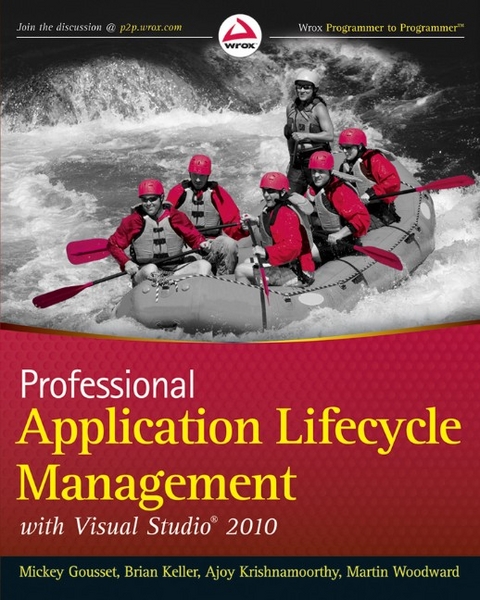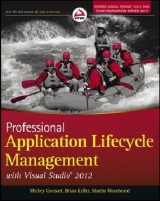
Professional Application Lifecycle Management with Visual Studio 2010
Wrox Press (Verlag)
978-0-470-48426-5 (ISBN)
- Titel ist leider vergriffen;
keine Neuauflage - Artikel merken
Get up to speed on Application Lifecycle Management (ALM) with Visual Studio 2010 through a combination of hands-on instruction and deep-dives.Microsoft has packed a lot of brand new testing and modeling tools into Visual Studio 2010, tools that previously were available only to Microsoft internal development teams. Developers will appreciate the focus on practical implementation techniques and best practices.A team of Microsoft insiders provides a nuts-and-bolts approach. This Wrox guide is designed as both a step-by-step guide and a reference for modeling, designing, and coordinating software development solutions at every level using Visual Studio 2010 and Visual Studio Team Foundation Server 2010.Visual Studio 2010 offers a complete lifecycle management system that covers modeling, testing, code analysis, collaboration, build and deployment tools.
MICKEY GOUSSET is a Senior Technical Developer for Infront Consulting Group, a consulting company focused on the Microsoft System Center family of products. He has been a Microsoft Team System MVP fi ve years running, a certifi ed professional in Team Foundation Server and SCOM 2007, and co-author (along with Jean-Luc David and Erik Gunvaldson) of the book Professional Team Foundation Server (Indianapolis: Wiley, 2006). Gousset runs Team System Rocks! (http://www.teamsystemrocks.com), a community site devoted to Visual Studio Team System and Visual Studio 2010, where he also blogs about Visual Studio and Team Foundation Server. He is also a co-host of the popular Team Foundation Server podcast, Radio TFS (http://www.radiotfs.com). He has spoken on Visual Studio and Team Foundation Server topics at various user groups, code camps, and conferences, including Microsoft Tech Ed Developer North America 2008 and 2009. When not writing or working with computers, Mickey enjoys a range of hobbies, from playing on Xbox Live ( Gamer Tag: HereBDragons ) to participating in local community theater. Nothing beats his favorite pastime though sitting on his couch with his lovely wife Amye, and their two Chihuahuas, Lucy and Linus. BRIAN KELLER is a Senior Technical Evangelist for Microsoft, specializing in Visual Studio and application lifecycle management. Keller has been with Microsoft since 2002, and has presented at conferences all over the world, including TechEd, Professional Developers Conference (PDC), and MIX. Keller is also a regular personality on MSDN s Channel 9 Web site, and is co-host of the popular show, This Week on Channel 9. Outside of work, he can usually be found enjoying the great outdoors while either rock climbing, backpacking, skiing, or surfing. AJOY KRISHNAMOORTHY is a Senior Product Manager in the Microsoft Patterns and Practices group. In this role, he focuses on planning the areas of investments and business strategy for Patterns and Practices. Prior to this role, Krishnamoorthy worked as a Senior Product Manager for Microsoft Visual Studio Team System. He has more than ten years of consulting experience, playing variety of roles, including developer, architect, and technical project manager. Krishnamoorthy has written articles for online and printed magazines, and co-authored several books on ASP.NET. You can check out his blog at http://blogs.msdn.com/ajoyk. Krishnamoorthy has an MBA from Ohio State University. Any spare time is spent with his family, playing board/card games with friends, watching sports (especially when the Ohio State Buckeyes are playing), and learning to play Tabla. MARTIN WOODWARD is currently the Program Manager for the Microsoft Visual Studio Team Foundation Server Cross-Platform Tools Team. Before joining Microsoft, Woodward was voted Team System MVP of the Year, and has spoken about Team Foundation Server at events internationally. Not only does Woodward bring a unique insight into the inner workings of the product he has experienced from more than a half-decade of real-world use at companies big and small, he is also always happy to share. When not working or speaking, Woodward can be found at his blog, http://www.woodwardweb.com.
INTRODUCTION xxix PART I: ARCHITECT CHAPTER 1: INTRODUCTION TO SOFTWARE ARCHITECTURE 3 Designing Visually 3 Microsoft s Modeling Strategy 4 From Objects to Services 7 New Architecture Tools in Visual Studio 2010 Ultimate 10 Summary 15 CHAPTER 2: TOP-DOWN DESIGN WITH USE CASE DIAGRAMS, ACTIVITY DIAGRAMS, AND SEQUENCE DIAGRAMS 17 Use Case Diagrams 18 Activity Diagrams 22 Sequence Diagrams 28 Summary 31 CHAPTER 3: TOP-DOWN DESIGN WITH COMPONENT AND CLASS DIAGRAMS 33 Component Diagrams 34 Class Diagrams 46 Summary 58 CHAPTER 4: ANALYZING APPLICATIONS USING ARCHITECTURE EXPLORER 59 Understanding the Code Base 60 Architecture Explorer Basics 61 Dependency Graphs 71 Summary 80 CHAPTER 5: USING LAYER DIAGRAMS 81 Creating a Layer Diagram 82 Defining Layers on a Layer Diagram 83 Defining Dependencies 86 Validating the Layer Diagram 88 Layer Diagrams and the Build Process 90 Summary 91 PART II: DEVELOPER CHAPTER 6: INTRODUCTION TO SOFTWARE DEVELOPMENT 95 What s New for Developers in Visual Studio 2010 96 Test Impact Analysis 97 Improved Code Analysis 97 Profiler Enhancements 97 Database Extensibility 97 Advanced Debugging with IntelliTrace 98 Improved Test-First Development Experience 98 Summary 98 CHAPTER 7: UNIT TESTING WITH THE UNIT TEST FRAMEWORK 99 Unit Testing Concepts 100 Visual Studio Unit Testing 102 Programming with the Unit Test Framework 110 Accessing Nonpublic Members from Tests 122 Code Generation 126 Code Coverage 129 Test Impact Analysis 131 Summary 137 CHAPTER 8: MANAGED CODE ANALYSIS AND CODE METRICS 139 The Need for Analysis Tools 140 Using Managed Code Analysis 140 Using the Command-Line Analysis Tool 151 Creating Code Analysis Rules 155 Code Metrics 163 Summary 165 CHAPTER 9: PROFILING AND PERFORMANCE 167 Introduction to Performance Analysis 168 Using the Profiler 169 Command-Line Profiling Utilities 195 Common Profiling Issues 198 Summary 199 CHAPTER 10: DATABASE DEVELOPMENT, TESTING, AND DEPLOYMENT 201 The Challenges of Database Change Management 202 Offline Schema Development 203 Creating a Database Project 207 Examining the Database Project 212 Making Schema Changes 215 Deploying Database Changes 221 Data Generation 224 Database Testing 227 Summary 241 CHAPTER 11: INTRODUCTION TO INTELLITRACE 243 Debugging Using IntelliTrace 243 New Features in Breakpoints 251 Pinnable Data Tips 253 Summary 255 PART III: TESTER CHAPTER 12: INTRODUCTION TO SOFTWARE TESTING 259 Role-Based Testing Tools 260 Types of Tests 260 Diagnostic Data Adapters 262 Microsoft Test Manager 264 Managing Automated Tests with Visual Studio 265 Summary 276 CHAPTER 13: WEB PERFORMANCE AND LOAD TESTING 277 Web Performance Tests 278 Load Tests 297 Command-Line Test Execution 312 Distributed Load Tests 313 Summary 317 CHAPTER 14: MANUAL TESTING 319 Microsoft Test Manager 319 Using Test Plans 320 Running Tests and Tracking Results 330 Running Automated Tests 336 Summary 338 CHAPTER 15: CODED USER INTERFACE TESTING 339 Creating Coded UI Tests Using the Coded UI Test Builder 340 Creating Coded UI Tests Using Action Recordings 351 Supported Technologies 354 Summary 354 CHAPTER 16: LAB MANAGEMENT 357 Lab Management Infrastructure 358 Virtual Environments 360 Testing with Virtual Environments 366 Automated Build-Deploy-Test with Virtual Environments 371 Physical Environments 375 Summary 376 PART IV: TEAM FOUNDATION SERVER CHAPTER 17: INTRODUCTION TO TEAM FOUNDATION SERVER 379 What Is Team Foundation Server? 380 Team Foundation Server Core Concepts 380 Accessing Team Foundation Server 392 What s New in Team Foundation Server 2010 400 Adopting Team Foundation Server 402 Summary 404 CHAPTER 18: TEAM FOUNDATION ARCHITECTURE 405 Team Foundation Server Logical Architecture 406 Physical Architecture 412 Deployment Scenarios 415 Summary 421 CHAPTER 19: TEAM FOUNDATION VERSION CONTROL 423 Team Foundation Version Control and Visual SourceSafe (VSS) 2005 424 Setting up Version Control 425 Using the Source Control Explorer 427 Check-In and Check-Out 432 Shelving 438 Branching and Merging 440 Command-Line Tools 444 Summary 445 CHAPTER 20: BRANCHING AND MERGING 447 Understanding Branching and Merging 448 Common Branching Strategies 449 Basic Branching Plan 452 Advanced Branching Plan 467 Summary 470 CHAPTER 21: TEAM FOUNDATION BUILD 471 Team Foundation Build 472 What s New in Team Foundation Build 2010 474 Team Foundation Build Architecture 477 Working with Builds 478 Team Build Process 492 Summary 517 PART V: PROJECT/PROCESS MANAGEMENT CHAPTER 22: INTRODUCTION TO PROJECT MANAGEMENT 521 Team Project Setup and Configuration 522 Planning Your Project 528 All Things Work Items 529 Using MS Office with Team Foundation Server 538 Summary 547 CHAPTER 23: PROCESS TEMPLATES 549 Understanding a Process Template 550 Process Templates Out of the Box 551 Partner and Community Templates 568 Summary 569 CHAPTER 24: USING REPORTS, PORTALS, AND DASHBOARDS 571 Team Foundation Server Reporting 572 Working with Team Foundation Server Reports 575 Summary 596 CHAPTER 25: AGILE PLANNING USING PLANNING WORKBOOKS 599 Product Backlog 600 Product Planning Workbook 602 Iteration Planning 607 Iteration Backlog Workbook 608 Tracking the Iteration 613 Summary 614 CHAPTER 26: PROCESS TEMPLATE CUSTOMIZATIONS 615 Customizing Process Templates 616 Tools for Customization 620 Uploading Process Templates in Team Foundation Server 631 Deleting Process Templates 631 Customizing Process Guidance 632 Summary 632 INDEX 633
| Erscheint lt. Verlag | 12.4.2010 |
|---|---|
| Zusatzinfo | Illustrations |
| Sprache | englisch |
| Maße | 188 x 232 mm |
| Gewicht | 1176 g |
| Themenwelt | Mathematik / Informatik ► Informatik ► Netzwerke |
| Mathematik / Informatik ► Informatik ► Programmiersprachen / -werkzeuge | |
| ISBN-10 | 0-470-48426-8 / 0470484268 |
| ISBN-13 | 978-0-470-48426-5 / 9780470484265 |
| Zustand | Neuware |
| Haben Sie eine Frage zum Produkt? |
aus dem Bereich



